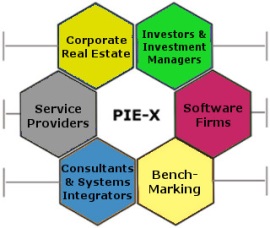
by Brianna Crandall — April 3, 2015—Simpler, more cost effective sharing of portfolio information is the mark of the new Portfolio Information Exchange Standard (PIE—X) from OSCRE, the membership-based nonprofit Open Standards Consortium for Real Estate.
Whether corporate or investment end users are expanding their real estate investment portfolios, changing service providers, acquiring or divesting properties, or getting updates on portfolio status, the PIE—X Standard facilitates and improves the quality of current, accurate data critical to the exchange of real estate portfolio information between buyers, sellers and business partners.
PIE—X is a direct response to significant trends in the real estate industry—an increasing number and complexity of portfolio transactions both corporate and investment, continued growth of outsourcing, high demand for quality information from multiple sources and systems, and increasing rigor around data governance.
“There are massive portfolios being acquired as a result of mergers, acquisitions and divestitures, especially in the multi—unit retailer and corporate occupier segments of the real estate industry right now,” said Brad Sill, Director of Real Foundations and a member of the workgroup that developed the standard. “PIE—X provides tremendous benefit from the due diligence phase through the final portfolio exchange. Without using PIE—X, these transactions are painful and labor intensive to exchange portfolio and lease information at any level.”
How it works
The features and flexibility of PIE—X comprise a breakthrough in the implementation of real estate information exchange standards. The standard is built around a core set of property data that is considered critical for understanding the composition and status of a portfolio at the due diligence and final transfer stages of a portfolio transaction, as well as for continuing portfolio management.
Starting with this core data set, users have the flexibility to implement the standard in a number of ways, depending on their needs. The standard also includes hierarchies of spaces and places to aid in consistent data management and reporting across a complex portfolio. Importantly, the standard also has applications across the entire range of business processes over the life of a portfolio.
PIE—X applications for key industry stakeholders
For Corporate End—Users: PIE—X provides the basis for portfolio transactions and portfolio management in coordination with their global service providers. The data elements include the occupier’s perspective either as a tenant or an owner, including rents, operating costs, leases and utilization, and supports international transactions and operations.
For Investment Companies: The standard provides the key data needed to assess the quality of a portfolio. PIE—X encompasses property income, expenses, and occupancy information as well as details on leases and tenants, and supports international transactions and operations.
For Service Providers: Portfolio information exchanges are critical when transitioning major accounts and are the core of fulfilling an increasingly frequent integrator role. Shared clients are much more common, requiring the frequent exchange of portfolio information between service providers and their clients. Standards like PIE—X become central to data management requirements of outsourcing contracts.
For Leading Software Firms: Software firms now have the opportunity to implement PIE—X in their core products in response to high market demand for exchanging portfolio information.
For Consultants and Systems Integrators: The new PIE—X Standard comes packaged with a methodology and guidance on how to implement standards as part of their client services, and provides an excellent starting point in building a common data model for the major systems projects they lead for their clients.
Organizations can also use the PIE—X Standard for benchmarking to assemble data from multiple sources and service firms around the world. This approach enables them to effectively benchmark against competitors in areas such as costs, portfolio mix and space utilization.




